“Turning and turning in the widening gyre
The falcon cannot hear the falconer;
Things fall apart; the centre cannot hold;
Mere anarchy is loosed upon the world,
The blood-dimmed tide is loosed, and everywhere
The ceremony of innocence is drowned;
The best lack all conviction, while the worst
Are full of passionate intensity.”
Read More Even after three weeks, it is hard to accept the startling changes in the world flooding us from the Trump administration. If more citizens had read Project 2025, would that have changed their votes and the outcome of the last election? Did we mistake the playbook as less consequential than it has turned out to be
Read MoreWe knew that 2025 was going to be a year of significant change because of the election of a convicted felon to the presidency. Still, history sometimes takes a winding path and that’s where we are now, as we prepare for Congressional hearings next week on Cabinet appointees and the inauguration of Trump on January 20th, where, on his first day in office, Trump has promised at least 100 presidential orders as well as the deportation of an untold number of “illegal immigrants” who have lives, families, and homes in The Land of the Free.
Read MoreWe seem to have come to a reckoning point in American history where explanations we have relied upon for years should be re-examined. From various analyses of voting data, many are surprised that it’s white people who made the difference in Trump’s numbers. We need to better understand the issues that have the most influence over voters and how to present them better going forward, even from thin minority positions in both Houses. There is a mid-term election in two years.
Read MoreWe're six days past the election of former President Trump as our next president. Both the press and social media are devoting inches if not pages of copy to try to analyze why Vice President Harris lost to Trump. The fact of the matter is that there are many reasons, and to focus on the loss itself does not leave much room to make plans that anticipate the new administration's first days in office. Complicating such an effort is the fact that we live in different states, so different efforts are already underway in blue states like Washington and California.
Read More"That no free government, nor the blessings of liberty, can be preserved to any people, but by a firm adherence to justice, moderation, temperance, frugality, and virtue; by frequent recurrence to fundamental principles; and by the recognition by all citizens that they have duties as well as rights, and that such rights cannot be enjoyed save in a society where law is respected and due process is observed.” -- George Mason
Read MoreMost Septembers, I write here about 9/11, a day where nearly 3,000 people died at the hands of foreign terrorists -- surely a day that will never be forgotten in our nation’s history. I use this month to press for four recommendations from the 9/ll Commission Report that have yet to be implemented 20+ years later. This year, I’d like to use my time to salute the courageous members of New York City’s fire and police departments who died or were injured on the job, as well as emergency medical technicians and emergency room personnel in Manhattan hospitals who cared for those who survived or who were injured while helping others that day.
Read MoreSetting aside the political landscape for a moment, it’s been a whirlwind of a month. There have been incidents that look like repeated examples of the same old challenges – the search for a permanent ceasefire in the Mideast, watching Ukraine struggle valiantly against Russian aggression, and what NOAA calls “an early and violent start” to the 2024 Atlantic hurricane season, illustrated by Hurricane Beryl and Tropical Storm Debby. These have been interspersed with newer infrastructure challenges like getting the two astronauts in the Boeing Starliner home from space and hardening obvious attack surfaces from aggressors, whether the victim is Microsoft, entire judicial districts, or the former president.
Read MoreTwice in my long and varied career I stepped away from structured institutions to build unconventional business models. The first was Delphi Computers & Peripherals (1984-1999), early in the PC technology evolution that we all take for granted now. I learned a great deal from the experience, hired an amazing staff, won a number of awards, and grew Delphi to a multimillion dollar company.
Read MoreThis country has experienced chaos since it was founded. It was born out of a belief that there was a form of government that could be organized out of the consent of the governed, different than a monarchy, where the peoples’ rights were not acknowledged or protected.
Read More









